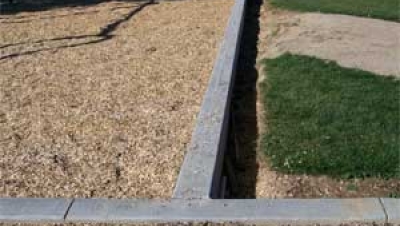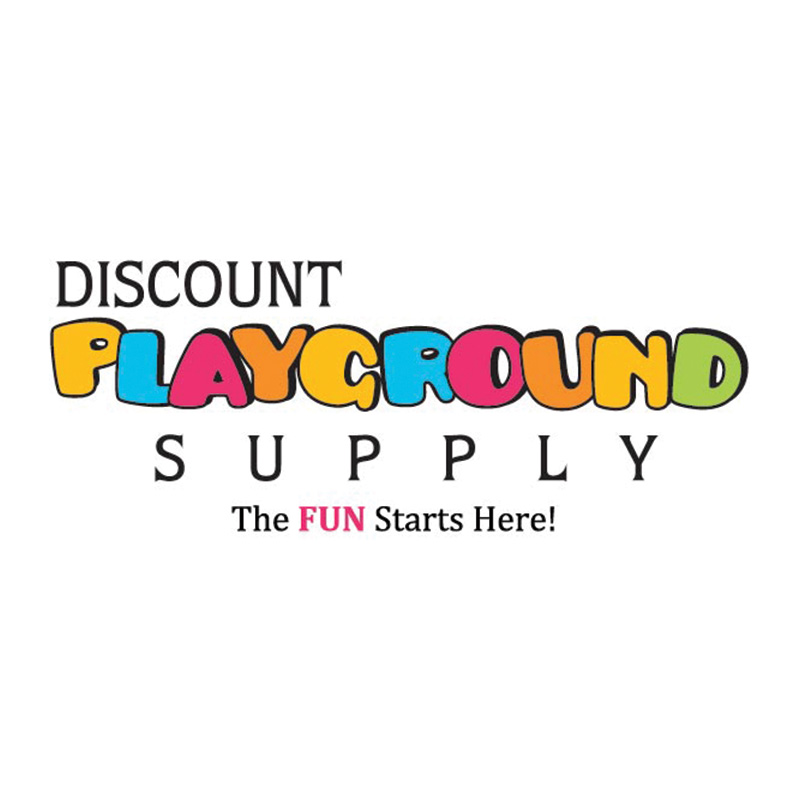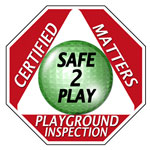An injury on North American public and private playgrounds is thought to occur every two minutes. Readers of Today’s Playground know that one of the best playground injury prevention practices is to provide adequate resilient surfacing under and around playground equipment. What exactly is “adequate” and how does a playground owner/operator know if the minimum standard of care has been provided as a precaution to a fall-related injury? A quick reflection of our past helps us understand how the playground equipment industry identified the need for a certification program for resilient surfacing.
During the mid to late 1970’s until the early 1990’s, sand, pea gravel, and wood chips were becoming the most common playground surfacing materials maintained under and around public playground equipment. During this period most playgrounds throughout North America were moved off the “blacktop” (asphalt), grass was removed and a loose-fill type of surfacing spread under and around the equipment. Certainly, many serious injuries were prevented by this improvement. However, over time, the lack of maintenance to these surfaces often resulted in a new type of playground hazard, a false sense of security. A one or two-inch depth of loose fill material over a hard surface such as compacted earth was considered by some industry experts as being more hazardous than a concrete or asphalt surface because the child may feel protected (consequently play with more risk behavior) when they actually are not!
Suddenly, playground owners and operators became extremely interested in manufactured playground surfacing products. Thick and soft tiles were being produced from bonded recycled rubber or virgin vulcanized rubber. Virgin and recycled wood was manufactured into extremely resilient engineered wood fiber and new bold designs combining a recycled rubber cushion base with a colorful EPDM wear course (poured-in-place) were being installed. With these new manufactured products came vast amounts of new information on the resiliency and safety protection of these products.
Simultaneous with the introduction of new playground surfacing products, new safety standards and guidelines were being drafted. In 1991, the Consumer Product Safety Commission (CPSC) revised their Handbook for Public Playground Safety, a document designed to provide guidelines for the efforts aimed at making playgrounds safer. The revised CPSC guidelines included information regarding the types of surfacing and their respective fall heights when measured using an instrumented metal head form (similar to the helmet testing device). CPSC recommended “the surfacing material used under and around a particular piece of playground equipment should have a critical height value of at least the height of the highest designated play surface on the equipment. This height is the fall height for the equipment.” ASTM International, in collaboration with CPSC research data, surfacing manufacturers, and playground safety experts, created the ASTM F1292 Standard Specification for Impact Attenuation Under and Around Playground Equipment.
The Need for a Third Party Certification Program
Shortly after the completion of the ASTM F1292 standard, playground surfacing manufacturers, especially those who participated in the standard development process, began to declare their surfacing products compliant with ASTM F1292. Many manufacturers submitted their surfacing products to independent laboratories for testing to the ASTM 1292 standard and would provide copies of test results to prospective customers to prove their products’ performance. As IPEMA’s (International Play Equipment Manufacturers Association) Equipment Certification program was gaining momentum throughout the playground industry, surfacing manufacturers rallied together under IPEMA ‘s umbrella and created a similar Certification program for manufactured surfacing products. Elouise Bird, President of Sof’ Fall Inc., manufacturer of Sof’Fall engineered wood fiber stated, “IPEMA’s surfacing certification program legitimizes the playground surfacing industry, makes sure the participating companies have up to date testing and places this information in a centralized and non-biased program that greatly benefits the consuming public.” As the certification program met the need for providing proof of impact attenuation, it was subsequently combined with the need to eliminate “tramp metals” such as nails, staples and/or other metal particles from engineered wood fiber.
The Teeth of the Equipment Certification Program
IPEMA’s certification program for playground surfacing provides compliance with ASTM F1292-99 Standard and, for engineered wood fiber, section 4.6 of ASTM F2075-01a for testing the presence of Tramp Metals. Any entity that offers public playground surfacing for sale may participate in this voluntary program in accordance with IPEMA’s certification program for playground surfacing License Agreement and Procedural Guide. The purpose of this certification program is to assure the playground owner/operator, by the presence of a certification logo and listing in a website directory, that representative samples of the products bearing the logo have been tested and are in compliance with the applicable requirements of the current published ASTM F1292-99 Standard Specification for Impact Attenuation of Surface Systems Under and Around Playground Equipment, and for engineered wood fiber, also, ASTM F2075-01a, Standard Specification for Engineered Wood Fiber for use as a Playground Safety Surface Under and Around Playground Equipment, sections 4.6 & 9, for testing the presence of Tramp Metal, independently validated in accordance with ASTM E1906 Standard Guide for General Requirements for Bodies Operating Product Certification Systems.
IPEMA utilizes Detroit Testing Laboratory, Inc. (DTL) as the programs’ independent validator to perform inspections, tests and review manufacturers’ records on a periodic basis. Prior to DTL’s inspection, the participant submits evidence of conformity to the standard in the form of test results performed in the last five years corresponding to the current ASTM F1292 standard revision from an A2LA accredited lab for each product. DTL then schedules and executes the main office inspection to verify the following:
On-site random certified sample testing
Written quality control assurance program
Installation instructions clear and concise
Sufficient customer service discipline
Multiple supplier inspections performed each year
If applicable, witness poured-in-place installation and test sample
Once the validator has determined the participant’s facilities and test procedures are adequate, the participant may begin to test their products and certify compliance to the appropriate standard. Participants then submit a completed request for validation forms for all product models that have been tested and certified as compliant. The Surfacing certification committee provides detailed forms to help guide participants in their written and graphic product submittal process. The Validator is the sole judge as to whether the information provided is adequate to validate products or if additional information or tests are needed.
Upon successful completion of the validation process, the participant, in order to maintain their IPEMA product certification status, must retest a minimum of 20 percent of its validated surfacing products each calendar year in order to maintain their status. Product tests expire on December 31st following the fifth anniversary of the date on which the test was performed. This ensures that each participant’s products are tested at least once every five years; facilities are re-evaluated annually.
Surfacing products certified by participants and validated by DTL are allowed to carry IPEMA’s surfacing certification seal in their product sales literature and advertisements. The use of the certification seal is carefully monitored by IPEMA’s board of directors and legal counsel to ensure program credibility and to prevent any misuse of the seal. Additionally, all validated products are added to IPEMA’s website, www.ipema.org, within 30 days of their validation, thus allowing prospective customers to review participants’ IPEMA surfacing certification. Another benefit of the website is that manufacturers’ sales representatives are able to quickly create up-to-date certificates of their IPEMA certified products to share with clients by simply downloading a listing of a participants’ validated model numbers and descriptions.
Ongoing Improvements to the Standard
Every year, IPEMA’s surfacing certification committee holds six or more meetings either by telephone conference or prior to the ASTM F-08.63 committee meetings. Ted Illjes, the equipment certification committee chair said, “The purpose of the committee is to administer the program. This includes hiring the Validator, making the License Agreement and Procedural Guide available to the participants, and more importantly, we continue to improve the certification program like the recent addition of the Tramp Metal standard.” Mr. Illjes further stated, “Updated surfacing technology and information with specific recommendations are passed onto the ASTM F-08.63 committee that is responsible for writing these standards.”
Playground owners/operators can now purchase, install and maintain playground surfacing products that are IPEMA Certified, thus raising the standard of care in our playground environments throughout the world.
References:
- ASTM International, 100 Bar Harbor Drive, West Conshohocken, PA 19428 www.astm.org
- Detroit Testing Laboratory, 7111 East 11 Mile Road, Warren, MI 48092 www.dtl-inc.com
- International Play Equipment Manufacturers Association, Inc., 8300 Colesville Road, Suite 250, Silver Spring, MC 20910 www.ipema.org
- National Playground Safety Institute, c/o NRPA, 22377 Belmont Ridge Road, Ashburn, VA 20148 www.nrpa.org
- U.S. Consumer Product Safety Commission, Washington, D.C. 20207-0001 www.cpsc.g










Add new comment